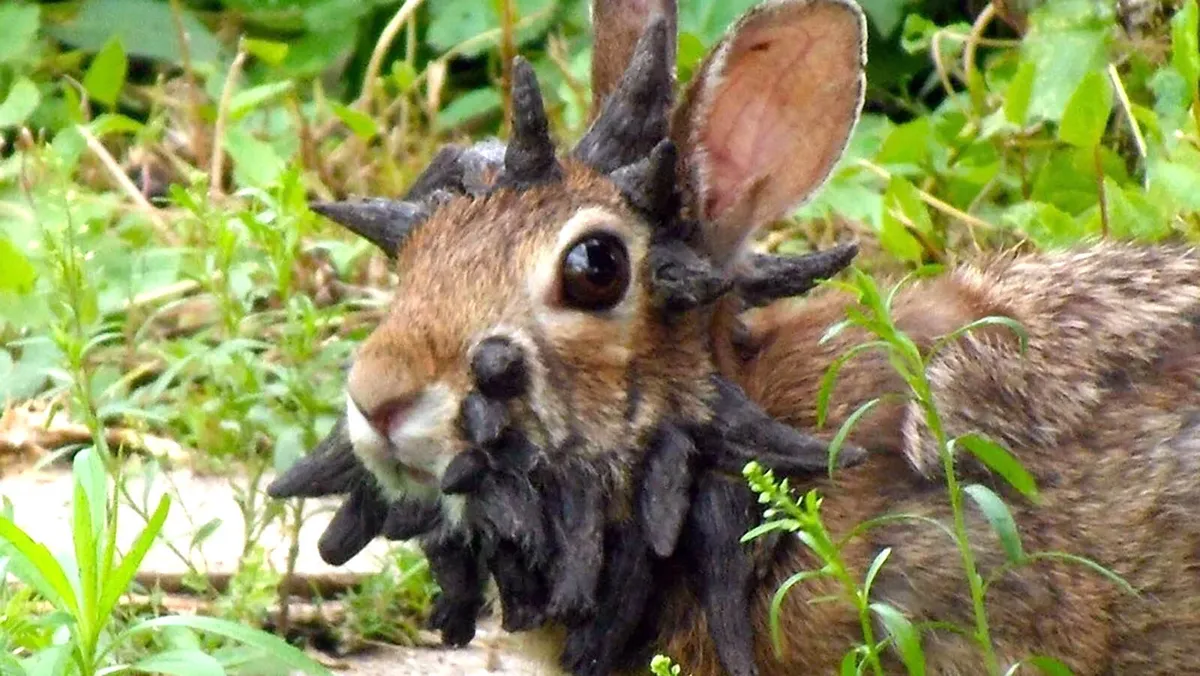
Deep within the rugged wilderness of northern Colorado, a common cottontail rabbit is undergoing a startling transformation that has captured the attention of wildlife enthusiasts and social media users alike. Under the eerie glow of the full moon, this ordinary creature sprouts hard, pointed protrusions resembling devil horns from behind its soft ears. Around its large eyes, black, writhing masses twist like tentacles, while dark, forked barbs extend from its mouth, evoking images of a Lovecraftian horror. However, upon closer inspection, this creature is not a monster but a rabbit affected by the Shope papilloma virus, a disease that leads to the growth of keratin-based structures around its face and neck.
The Shope papilloma virus is making headlines as images of infected rabbits flood social media, with many likening their ghastly appearance to that of Frankenstein’s monster or a zombie. While no infected rabbits have been documented in Wyoming, sightings have occurred as close as Fort Collins, Colorado, raising concerns that the virus may soon cross into the Cowboy State. Laurie Hess, an exotic pet veterinarian from Bedford Hills, New York, explained to Cowboy State Daily that this virus is typically not life-threatening to rabbits. She compared the horn-like growths to warts in humans, stating, “It’s been around forever; it’s a virus, it’s nothing new.”
Hess reassured the public that while the appearance of these growths may be alarming, they are usually benign and may eventually fall off. “It’s just the body’s reaction to wall off the virus as it divides, forming a pile of protein in the shape of a horn,” she noted. In rare cases, the growths could develop into malignant cancer, but this is uncommon. Most importantly, Hess emphasized that the Shope papilloma virus is not transmittable to humans or other pets, making it a concern primarily for rabbit populations.
The spread of the Shope papilloma virus is facilitated primarily through insect vectors, with a late summer surge in mosquito populations creating ideal conditions for transmission. Hess advised owners of exotic pets, particularly rabbits, to schedule annual veterinary check-ups to monitor for unusual diseases. As the Wyoming Game and Fish Department monitors the movement of rabbits from northern Colorado, they have confirmed that they do not plan to intervene if the rabbits cross into the state, as the virus poses no threat to local wildlife.
Public Information Officer Amanda Fry emphasized that, while the infection may appear alarming, it is not fatal unless it interferes with the rabbit’s ability to eat and drink. “We recommend giving these animals space if encountered,” Fry said, reassuring the public that the virus does not pose a significant risk to rabbit populations or their ecological roles.
While the scientific explanation for horned rabbits is clear, some residents of Wyoming speculate that these sightings are linked to the legendary jackalope, a mythical creature with the body of a jackrabbit and the antlers of an antelope. The city of Douglas, Wyoming, credits the Herrick family with the creation of the jackalope legend, which originated when a taxidermist named Doug Herrick mounted a rabbit carcass next to a pair of antlers. “My great grandmother named it ‘jackalope,’” said Luke Herrick, a third-generation taxidermist in Douglas, highlighting the enduring appeal of this whimsical creature.
Mounted jackalopes have become a signature offering at Herrick Big Horn Taxidermy, with Herrick revealing that they sell more jackalopes than any other taxidermy items. “We sell twice as much as we do our little animals,” he remarked, noting the cultural significance of the jackalope in Douglas.
Jenna Rose, a jackalope scholar at the Douglas Railroad Museum, pointed out the intriguing coincidence that Richard Shope discovered the papilloma virus in rabbits in the 1930s, around the same time the jackalope legend began to spread. “I’ve always wondered if part of it was the papilloma virus that caused the rabbits to develop horns,” Rose said. The jackalope has since gained a reputation for its whimsical traits, such as singing cowboy songs and drinking whiskey during electrical storms, further embedding it into local folklore.
The myth of the jackalope has not only become a beloved part of Douglas’s identity but also a tourist attraction, inspiring visitors to seek out the legendary creature just as they would search for other mythical beings like the Loch Ness Monster. The city even features the jackalope on its emblem, and the museum produces playful merchandise, including jackalope hunting licenses, which humorously allow the bearer to hunt jackalopes at unconventional hours.
While the Shope papilloma virus presents a fascinating case study in wildlife health, it also brings to light the enduring power of myth and folklore in shaping our understanding of the natural world. As the state of Wyoming continues to monitor the situation, it remains clear that the story of the horned rabbits and the legendary jackalope will persist in captivating the imaginations of those who encounter them. Whether viewed through the lens of science or legend, these creatures remind us of the extraordinary wonders that exist in the wilderness.
For more information on wildlife health and updates on the Shope papilloma virus, stay tuned to local news outlets and wildlife organizations.